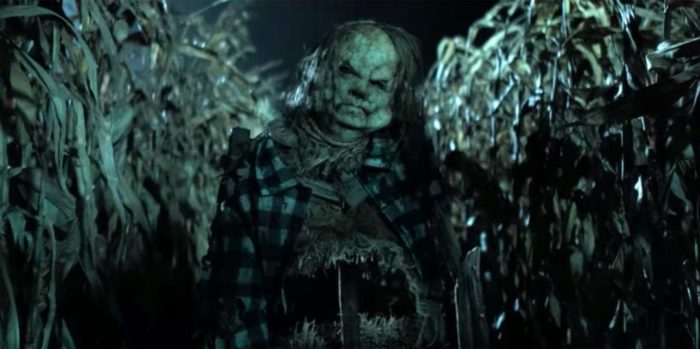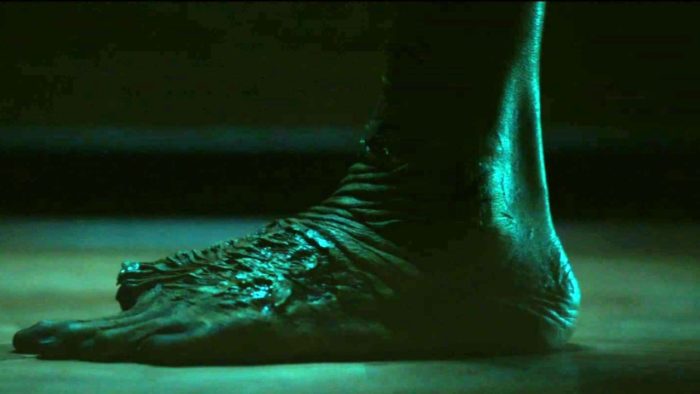Halloween movies aren’t generally known for having particularly deep messages. Nobody says they want to curl up on the couch in October and watch a nice morality tale. No, most of us want films that are just dumb, scary fun, and we don’t even think about what they might actually mean. But sometimes, we get a bit more than we bargained for. Sometimes our scary fun is a lot smarter than we expected, so we get a legit message along with our horror. Case in point: Scary Stories to Tell in the Dark.
While Scary Stories to Tell in the Dark isn’t entirely about Halloween, it starts off on this spookiest of holidays, and its story begins in earnest when a horror-obsessed teenager makes a crucial mistake on Halloween night. The film takes place during the Vietnam War era, and it follows four teenagers—Stella, Chuck, Auggie, and their new friend Ramón—who break into an abandoned house and awaken an evil force that begins to snatch away local high schoolers one by one.
Admittedly, that brief plot synopsis doesn’t sound like it would contain much of a message beyond “don’t awaken evil ghosts,” but a closer look tells a different story. Scary Stories to Tell in the Dark is actually all about peace and non-violence, so let’s take a deep dive into this fun Halloween film and see just how it teaches us its important lesson.
The Plot

Let’s start by recapping the plot in a bit more detail. The house the kids break into used to be owned by the Bellows family, and according to local legend, they kept their daughter Sarah locked inside. They never let her go anywhere, but despite her confinement, she still managed to murder kids around town. She would also tell scary stories to children who visited the house, and sometimes, those kids never returned home. She eventually hanged herself, but according to the legend, you could still go to her house and ask her to tell you a scary story. And if you did, it would be the last story you ever heard.
When the four main characters break into this house on Halloween night, they find the book Sarah used to write her stories in, and Stella is particularly intrigued by it. She quietly asks Sarah to tell her a story, and when they leave, she takes the book home with her. Soon afterward, new stories begin to write themselves in the book, and as they appear, kids start to vanish one by one.
Stella and her friends suspect that Sarah Bellows is behind these disappearances, so they go to the town hospital to learn more about her. They look into her records, and to their surprise, they discover that the legend is wrong. She wasn’t the one who killed the local children. Instead, they were poisoned by the mercury from the Bellows family’s paper mill. In fact, Sarah actually wanted to reveal the truth, but her family covered it up and blamed her instead. They tried to get her to confess to the murders, and when she refused, they tortured her with electroshock therapy and isolation therapy.
Armed with this knowledge, Stella goes back to the Bellows’ house in the final act and convinces Sarah to stop lashing out at innocent kids, so the disappearances stop. However, before Scary Stories to Tell in the Dark ends, one final teenager gets tragically whisked away. At the beginning of the third act, we find out that Ramón is actually a draft dodger, and when the story comes to a close, he stops running and gets shipped off to the war.
A Message of Peace and Non-Violence

Now that we have the basic plot down, it’s time to take a closer look at some of the details. How exactly does Scary Stories to Tell in the Dark promote peace and non-violence? Let’s start by looking at Stella’s encounter with Sarah Bellows at the end of the film. Just when it looks like Sarah is going to take her too, Stella stands up for herself and reprimands Sarah for the way she’s been taking her anger out on others.
She says that she knows Sarah was an abuse victim, and she acknowledges that what her family did to her was wrong, but she also says that Sarah’s abusive past doesn’t justify her horrific actions in the present. The suffering her family put her through doesn’t make it okay for her to hurt innocent people. Stella even goes so far as to accuse Sarah of having become a monster, and at the end of it all, she encourages her to let go of her painful past. After a few minutes, Sarah agrees to relent, and she puts an end to her monstrous ways.
With that, the basic message of Scary Stories to Tell in the Dark becomes pretty clear: violence against innocent people is never okay. In particular, we should never hurt other people just because we’ve been hurt before. Sarah Bellows essentially functions as a stand-in for the audience, so what Stella tells her applies to our lives as well. Like Sarah, we’ve all experienced our share of pain and suffering, and we’re undoubtedly going to experience more in the future, but no matter how bad it’s been, we should never take it out on others.
If we give in to our anger and rage, we’ll become monsters just like she did. We’ll become the villains in our own stories, and we’ll just continue the cycle of pain. We’ll be treating others the same way we’ve been treated, and if it wasn’t okay when we experienced it, it won’t be okay when we dole it out, either. Instead, peace is always the way to go, and if we have unresolved pain or trauma in our lives, we have to find healthy, non-violent ways to heal from it.
An Anti-War Message

If that were all Scary Stories to Tell in the Dark had to tell us, it would be enough. It’s an important message we can never hear too many times, but the film actually goes beyond that general principle and applies it to something a bit more specific. Remember, this story takes place during the Vietnam War era, and that wasn’t just a random choice by the filmmakers. No, they very deliberately chose this setting to convey a message about the Vietnam War and, by extension, about war in general.
When Stella finds out that Ramón is running away from the draft, he explains why he did it. He says that his brother died in Vietnam, and he didn’t want to suffer the same fate. However, when the story comes to a close, he’s no longer able to run, and he’s shipped off to Vietnam, setting up a parallel between Sarah Bellows and the war.
See, even though Sarah never takes Ramón, he still suffers the same fate as her victims. The war makes him “disappear” just like they did, and he’s not the only one. Countless young men, often just teenagers, were whisked away by the Vietnam War, and many were never seen by their families again. It was one of the worst and most tragic debacles in the annals of American history, and it directly parallels the actions of Sarah Bellows in Scary Stories to Tell in the Dark.
And if there’s any doubt about that, consider Tommy, the local bully who becomes the first of Sarah’s victims. In the opening scene, we see him triumphantly walking out of an army recruitment office, and he tells his friends, “I did it,” presumably meaning that he successfully joined the army. Then, when the first new story begins to write itself in Sarah’s book, he gets turned into a scarecrow and disappears.
When Stella hears about his disappearance, she becomes worried that Sarah had something to do with it, so she tells her friends about the book. Unfortunately, they don’t really believe her, and Auggie remains particularly unconvinced. He doesn’t think anything supernatural is going on, and he even suggests that the kid might’ve gone off to Vietnam early.

At that point in the film, you don’t think anything of Auggie’s comment about the war, but when you look back on it after the credits roll, you realize just how meaningful it truly is. It points out that Sarah Bellows takes kids away from their families and friends just like the Vietnam War did, so it cleverly and subtly begins to set up the parallel between them, making it just about impossible to miss.
And from that parallel, we can extrapolate and say that not only does Scary Stories to Tell in the Dark point out the terrible tragedies of the Vietnam War, but it’s really about the horrors of war, in general. Just like Sarah Bellows represents the audience, so too does the Vietnam War represent all armed conflict. Vietnam wasn’t the only time young men and teenagers didn’t return home to their families. That happens in every war, and it’s just as terrible every time.
In fact, the movie shows us how terrible it really is. The pain the characters feel when their loved ones are taken away by Sarah is the same pain people feel when their loved ones are taken away by war, so the film doesn’t just tell us that war is bad. It shows us. It lets us see how people react when their friends and relatives are taken away from them, so we can see the horrors of war for ourselves.
But even that’s not all. Scary Stories to Tell in the Dark doesn’t just show us how painful war is. It also makes us feel that pain ourselves. Granted, we obviously don’t experience the full extent of that grief, but when we’re sad that characters like Chuck and Auggie get taken away by Sarah Bellows, we experience a tiny fraction of what people feel when their loved ones are taken away by war. Like all good horror movies, it pulls us into its story and allows us to feel its message, making that message come alive in a unique and compelling way.
So at the end of the day, even though it’s easy to write off Scary Stories to Tell in the Dark as just another mindless monster movie, there’s actually a lot more to it than meets the eye. It’s all about peace and non-violence, on both a small and a large scale. It shows us just how evil violence is, whether it’s the horrors of war or the actions of one individual, and it tells us that peace is by far the better choice.
Granted, this is a movie, not a philosophical treatise, so it doesn’t get into the rare potential exceptions to its message (like legitimate self-defense), but that doesn’t negate the value of what it does say. These days, it often seems like people on every side of every issue, both international and domestic, are more than ready to hurt innocent people to get what they want, so we need to remember that there’s a better way. We need to remember that violent force should always be an absolute last resort, so whenever peace is an option, we should choose it every time.



